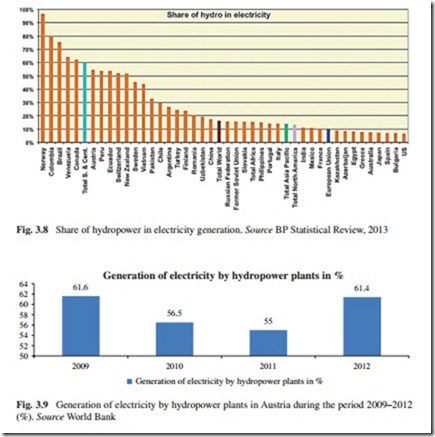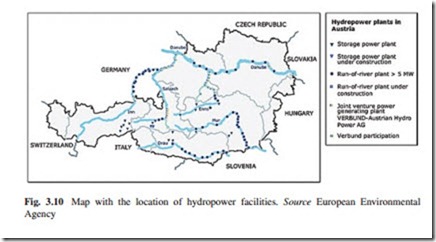Austria
The use of hydropower has a long tradition in Austria. Long before the discovery of electricity, hydropower was used in a decentralized manner to deliver mechanical energy to small industries. Toward the end of the nineteenth century, some water wheels were upgraded to become Austria’s first hydroelectric power plants. With the continuing electrification and rapidly increasing demand for electricity, hydropower plants became ever larger and more powerful. The development of hydroelectricity reached its peak during the period of rapid economic recovery in postwar Austria. Between 1950 and 1980, annual hydropower generation increased tenfold to 30 TWh. During the 1990s, a paradigm shift occurred that led to stagnation in hydropower development, due to ecological concerns. Recently, however, the climate change discourse and the European renewable energy source targets have made sure that hydropower became again more prominent on the political agenda. Today, Austrian hydropower plants generate 43 TWh per year and account for over 60 % of the national total electricity generation—one of the highest shares in Europe. There is currently 12.7 GW of installed hydropower capacity, 57 % of which consists of storage power plants with natural inflow (RESAP 2011).
According to the Handbook on Administrative Procedures (SMART 2009), surface water in Europe is public property. In Austria, there is a distinction between public and privately owned surface water. This brings about a number of differ- ences according to regulations in the Austrian Water Act (among others, for the applications for water use permits, as well as for measures for flood prevention). The private surface water in most cases is owned by the landowner holding the surrounding property—ground water since 1934 is being exclusively treated as privately owned. But for private property rights on the water, several restrictions apply—Austrian landowners cannot do with their water whatever they want. For the use of spring water from one’s own property, one does not need any official authorization. But, utilization exceeding the owner’s own needs requires official permission. If third parties are supplied by a domestic well, permission, according to the Water Act, is necessary. The administration states in a consensual procedure, how much water may be used, expressing it in liters per second.
Property rights in case of flowing private waters refer not only to the riverbed, but also to the water as such. In cases in which the riverbed belongs to a private owner, this does not necessarily apply to the water within it. Mostly, the flowing water is not subject to the owners’ disposition unless he holds a permit for its use issued after actively claiming it. Ownership structures become especially relevant as soon as commercial utilization is planned—for instance by the construction of a hydropower plant. The Water Act also states that private water, whenever pub- lic water is fed into it, automatically becomes public water, although the riverbed remains private.
Austria’s big rivers are all public. The Österreichische Bundesforste (Austrian National Forest Company—the biggest forest owner) is also considered as the big- gest water owner.
The Riparian Rights Authority exclusively executes an administrative power above all water bodies and above all kinds of water utilization and hydraulic con- struction. As far as public interest creates necessity for this, the Riparian Rights’ Authority may interfere into third parties’ rights.
Since 2001, the Länder Salzburg, Carinthia, Vorarlberg, Burgenland, and Styria operate a joint water information system. Apart from the financial aspects, this ini- tiative creates a simple and open access to the riparian database of the mentioned Länder (provinces). Everybody is granted access to the Riparian Rights Registry as far as this does not interfere with legally protected data.
The Riparian Rights’ Authority by decree may proclaim that certain parts of river catchment areas of waterworks gain the status of protected areas or sanctuar- ies in order to protect potable water resources. In these areas, certain activities are forbidden or restricted. By the stating of such a protected character and by restrict- ing water utilization rights, the need for maintenance of quality and quantity of ground water is respected.
For electricity generation plants that need a permit according to electricity law, a permit or notification according to building law regulations are not required, as these building law regulations are also to be considered in the permit procedure according to electricity law. In practice, the competent authority tries in case of revitalization or new construction of small hydropower, to carry out the particular
statutory permit procedures (Riparian right, Nature conservation right and Building right) within a coordinated procedure—unless eminent factors or circum- stances argues against this.
Permit according to the electricity right is required in case of construction, sig- nificant modification, and operation of electricity generation plants with installed bottleneck capacity of 30 kW or more.
The National Energy Strategy (Energiestrategie Österreich) explicitly states the aim of developing an additional 3.5 TWh of hydropower until 2015. Although there is enough potential to reach this goal, the time frame for this development could be a little bit unrealistic because of long licensing processes for the consid- eration and approval of new projects.
Hydropower Installed Capacity
In 2012, the installed hydropower capacity in Austria reached 10,585 MW, which is 0.2 % lower than the installed capacity reported in 2011 (11 MW of hydropower capacity was closed in 2011). The hydropower capacity installed in the country represents 47.07 % of the total electricity capacity installed and 62.73 % of the total renewable installed capacity of the country.
According to its hydropower installed capacity, Austria occupies the place 17 in the list of countries with hydropower facilities in operation with 1.10 % of the total world installed capacity. Within Europe, Austria occupies the place number 8 after Switzerland, with a share of 6.28 %. The annual growth rate of hydropower in Austria in the past 10 years was 0.80 %, but in real term, the hydropower capacity of the country increased in 7 of the past 10 years.
Electricity Generation and Consumption
In 2010, the generation of electricity by hydropower plants reached 37,945 MWh, according to Eurostat statistics. In 2012, the generation of electricity by the hydro- power plants in operation in the country reached 39,156 MWh; this represents an increase of 3.2 % with respect to 2011.
According to Fig. 3.8, Austria is the country within the EU with the high- est share in hydropower for the electricity generation with around 55 % of the total electricity generated by the country in 2012, after Canada and followed by Switzerland and Sweden within Europe.
The generation of electricity by hydropower plants in Austria during the period 2009–2012 is shown in Fig. 3.9.
According to Fig. 3.9, the generation of electricity in Austria during the period 2009–2012 decreased only 0.2 %. In 2012, the total electricity generated by hydropower plants was 39,156 MWh. The major decrease occurred during the
period 2009–2011 as a result of the economic and financial crisis, which is still affecting the whole Europe. It is expected that the generation of electricity by hydropower plants will increase, but very slowly during the coming years due to the decision of the government to increase the share of renewables in the production of electricity, particularly wind and solar energies.
Finally, it is important to highlight the following: Austria clearly has a hydro- power-dominated electricity system in which run-of-river power plants cover the base load, storage power plants cover peak loads, and pumped storage is used to store excess energy, mainly at night and over the weekend. However, this (simpli- fied) operation pattern is likely to change in the future. The demand for carbon- neutral electricity, the integration of more variable generation sources such as wind and solar power, and the continuous integration of the European electricity market will change the role of hydropower in Austria and its significance for the entire
European system. In particular, pumped-storage power plants11 will play an increasingly important role against the background of growing demands for peak- load electricity, fast, reliable and efficient balancing capabilities, ancillary services, reserve capacity, and black-start and storage capability (RESAP 2011).
According to Lukavsky (2014), in Austria operates a total of 440 hydropower plants12 of different sites all over the country (Fig. 3.10).
The government expects that pumped-storage capacity in Austria will grow significantly over the next decades. Pumped storage is currently the only storage technology that can manage the scale of the challenge ahead. Austria is, due to its topography, central location, water availability, and existing hydropower infra- structure and expertise, ideally placed for further development of pumped storage.

